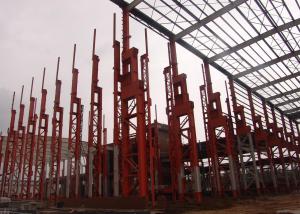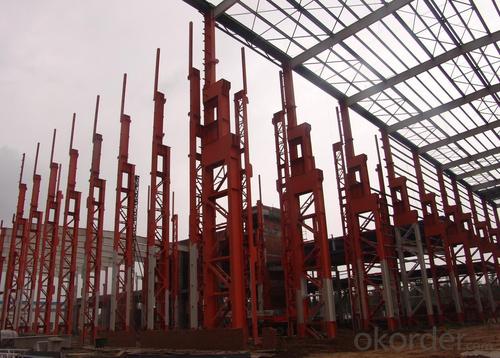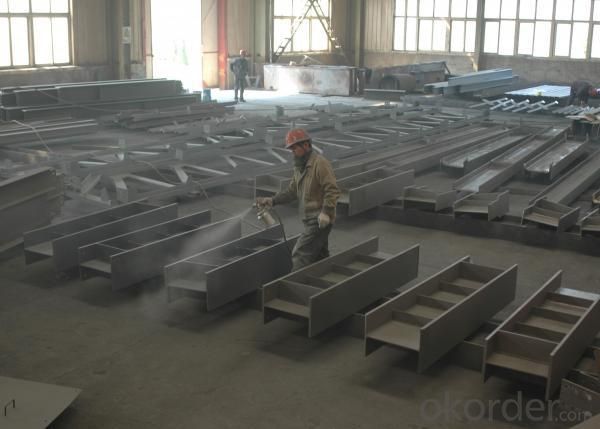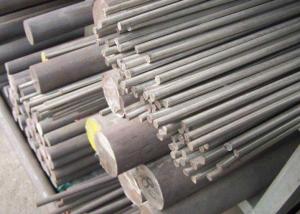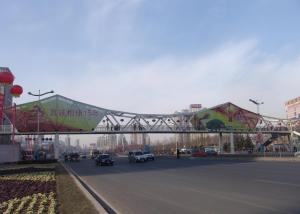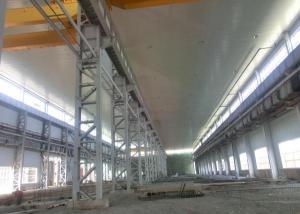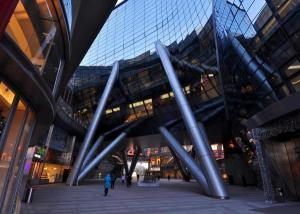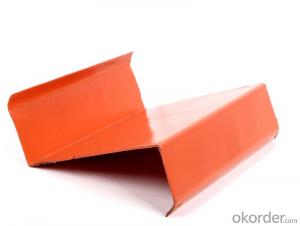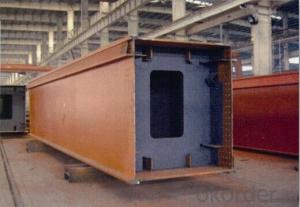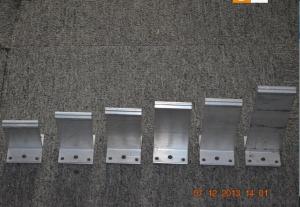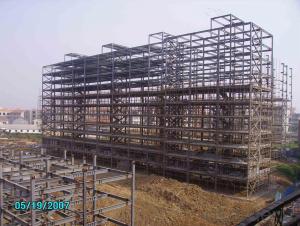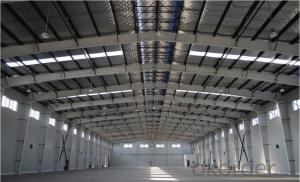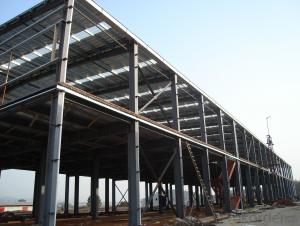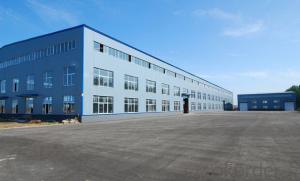Light Steel Structure Electric Plant
- Loading Port:
- Tianjin Port
- Payment Terms:
- TT or LC
- Min Order Qty:
- 10000 Square Meters m.t.
- Supply Capability:
- 50000 Square meters/Month m.t./month
OKorder Service Pledge
OKorder Financial Service
You Might Also Like
Specifications of light steel structure electric plant
Project type: light steel structure electric plant / electric workshop
The steel dosage: 2736MTs
Building area: 17600M2
The unit component weight: 18MTs
The span: 24m
|
Grade |
Chemical compositions | ||||
|
C |
Mn |
MAXIMUM(≤) | |||
|
Si |
S |
P | |||
|
Q345B |
≤0.2 |
1.00-1.60 |
0.55 |
0.04 |
0.04 |
|
Mechanical Properties | |||||
|
Yield point |
tensile strength |
Elongation | |||
|
16mm max |
16-40mm | ||||
|
345 |
325 |
470-630 |
21 | ||
1. GB standard material
2. High Structural safety and reliability
3. The production can reach GB/JIS/ISO/ASME standard
Packaging & Delivery of light steel structure electric plant
1. According to the project design and the component size, usually the main component parts are nude packing and shipped by bulk vessel. And the small parts are packed in box or suitable packages and shipped by containers.
2. This will be communicated and negotiated with buyer according to the design.
Engineering Design Software of light steel structure electric plant
Tekla Structure \ AUTO CAD \ PKPM software etc
⊙Complex spatial structure project detailed design
⊙Construct 3D-model and structure analysis. ensure the accuracy of the workshop drawings
⊙Steel structure detail ,project management, automatic Shop Drawing, BOM table automatic generation system.
⊙Control the whole structure design process, we can obtain higher efficiency and better results
Technical support of light steel structure electric plant
|
Worker |
Rate of frontline workers with certificate on duty reaches 100% |
|
Welder |
186 welders got AWS & ASME qualification 124 welders got JIS qualification 56 welders got DNV &BV qualification |
|
Technical inspector |
40 inspectors with UT 2 certificate 10 inspectors with RT 2 certificate 12 inspectors with MT 2 certificate 3 inspectors with UT3 certificate |
|
Engineer |
21 engineers with senior title 49 engineers with medium title 70 engineers with primary title. 61 First-Class Construction Engineers 182 Second-Class Construction Engineers |
|
International certification |
10 engineers with International Welding engineer, 8 engineers with CWI. |
Production Flow of light steel structure electric plant
Material preparation—cutting—fitting up—welding—component correction—rust removal—paint coating—packing—to storage and transportation (each process has the relevant inspection)
light steel structure plant welding light steel structure plant fitting-up
Usage/Applications of steel structure

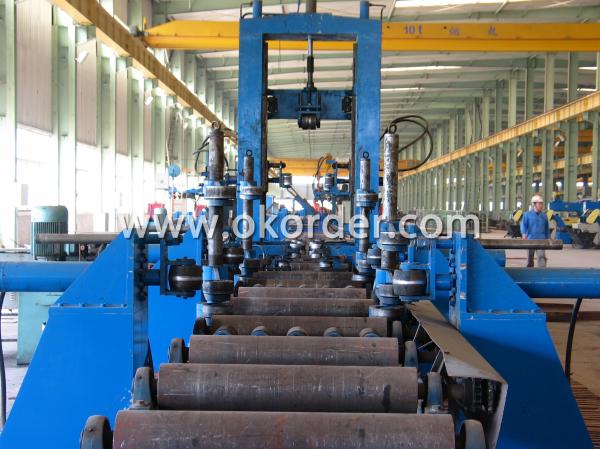
*Characters of Structure Steel
1. Steel is characterized by high strength, light weight, good rigidity, strong deformation capacity, so it is suitable for construction of large-span, super high and super-heavy buildings particularly;
2. It with good homogeneous and isotropic, is an ideal elastomer which perfectly fits the application of general engineering;
3. The material has good ductility and toughness, so it can have large deformation and it can well withstand dynamic loads;
4. Steel structure’s construction period is short;
5. Steel structure has high degree of industrialization and can realize-specialized production with high level of mechanization.
*Steel structure application
1. Heavy industrial plants: relatively large span and column spacing; with a heavy duty crane or large-tonnage cranes; or plants with 2 to 3 layers cranes; as well as some high-temperature workshop should adopt steel crane beams, steel components, steel roof, steel columns, etc. up to the whole structure.
2. Large span structure: the greater the span of the structure, the more significant economic benefits will have by reducing the weight of the structure
3. Towering structures and high-rise buildings: the towering structure, including high-voltage transmission line towers, substation structure, radio and television emission towers and masts, etc. These structures are mainly exposed to the wind load. Besides of its light weight and easy installation, structure steel can bring upon with more economic returns by reducing the wind load through its high-strength and smaller member section.
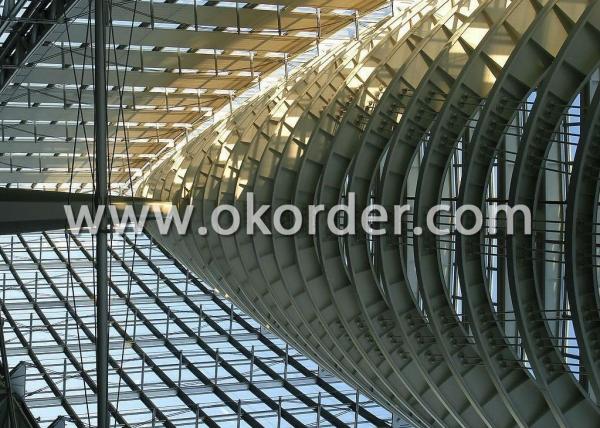
4. Structure under dynamic loads: As steel with good dynamic performance and toughness, so it can be used directly to crane beam bearing a greater or larger span bridge crane
5. Removable and mobile structures: Structure Steel can also apply to movable Exhibition hall and prefabricated house etc by virtue of its light weight, bolt connection, easy installation and uninstallation. In case of construction machinery, it is a must to use structure steel so as to reduce the structural weight.
6. Containers and pipes: the high-pressure pipe and pipeline, gas tank and boiler are all made of steel for the sake of its high strength and leakproofness
7. Light steel structure: light steel structures and portal frame structure combined with single angle or thin-walled structural steel with the advantages of light weight, build fast and steel saving etc., in recent years has been widely used.
8. Other buildings: Transport Corridor, trestle and various pipeline support frame, as well as blast furnaces and boilers frameworks are usually made of steel structure.
All in all, according to the reality, structure steel is widely used for high, large, heavy and light construction..
- Q: How are steel structures designed for blast resistance?
- Steel structures can be designed to resist blasts by incorporating several key principles. First, the structural system is typically designed to have a high degree of redundancy, meaning that even if one or more elements fail, the overall structure can still maintain its stability. This is achieved by using multiple load paths and ensuring that the load-bearing capacity of each member is sufficient to resist the blast forces. Additionally, blast-resistant steel structures often employ progressive collapse prevention strategies. This involves designing the structure to minimize the potential for a localized failure to propagate and cause a collapse of the entire building. Various techniques such as alternate load path design, robust connections, and post-blast stability measures are employed to achieve this objective. Another important aspect of blast resistance design is the selection of appropriate materials and their configuration. High-strength steel is commonly used to ensure that the structure can withstand the dynamic forces generated by an explosion. The layout and geometry of the structural elements are carefully considered to minimize potential weak points and enhance the overall resistance. Furthermore, blast-resistant steel structures may incorporate blast mitigation features such as sacrificial elements or energy-absorbing systems. These components are designed to absorb and dissipate the blast energy, reducing the impact on the main structural elements. They act as a buffer, absorbing and redirecting the blast wave to minimize the damage caused to the primary structure. Lastly, computer simulations and explosion modeling techniques play a crucial role in the design process. These tools allow engineers to accurately predict the behavior of steel structures under blast loads, enabling them to optimize the design for blast resistance. In summary, steel structures are designed for blast resistance by incorporating redundancy, progressive collapse prevention measures, appropriate material selection, blast mitigation features, and using advanced simulations to ensure their performance. These design strategies work together to create robust and resilient structures capable of withstanding the destructive forces of a blast.
- Q: How does steel perform in terms of fire resistance?
- Steel performs well in terms of fire resistance. It has a high melting point and does not easily combust or ignite. It retains its structural integrity even at high temperatures, making it an excellent choice for fire-resistant construction. Additionally, steel does not release toxic gases when exposed to fire, further enhancing its safety in fire incidents.
- Q: How are steel structures designed to be resistant to extreme temperature changes?
- Steel structures are designed to be resistant to extreme temperature changes through various measures. One key aspect is the selection of materials that possess high thermal conductivity. Steel, being an excellent conductor of heat, allows for the efficient transfer of thermal energy across its structure. This helps in minimizing the impact of temperature changes on the overall integrity of the steel structure. Another important consideration is the expansion and contraction of steel due to temperature fluctuations. Steel has a relatively high coefficient of thermal expansion, which means it expands when heated and contracts when cooled. To counteract these thermal movements, engineers incorporate expansion joints or gaps in the structure. These joints allow the steel to expand and contract without causing excessive stress or deformation. Additionally, the design may include flexible connections or other mechanisms to accommodate thermal movements. Furthermore, insulation materials can be applied to steel structures to reduce heat transfer. Insulation helps to maintain a more stable internal temperature by minimizing the effect of external temperature fluctuations. This is particularly crucial in extreme climates where temperature changes are frequent and significant. In certain cases, steel structures may also utilize passive cooling or heating systems to regulate temperature. This can involve shading devices, reflective surfaces, or ventilation systems that help in managing heat gain or loss. By implementing these strategies, the steel structure can better withstand extreme temperature changes while maintaining a comfortable and stable environment inside. Lastly, thorough analysis and testing are conducted during the design phase to ensure the steel structure's ability to withstand temperature-related stresses. Finite element analysis and other computer modeling techniques are employed to simulate the effects of extreme temperature changes on the structure. This allows engineers to identify potential weak points, make necessary adjustments, and optimize the overall design for enhanced resistance to temperature variations. In summary, steel structures are designed to resist extreme temperature changes by utilizing materials with high thermal conductivity, incorporating expansion joints, applying insulation, implementing passive cooling or heating systems, and conducting thorough analysis and testing. These measures ensure that a steel structure can withstand temperature fluctuations without compromising its stability, durability, and functionality.
- Q: What are the architectural possibilities with steel structures?
- Steel structures offer a wide range of architectural possibilities due to their strength, versatility, and flexibility. They allow for the creation of large, open spaces with minimal support columns, enabling architects to design innovative and unique structures. Steel can be molded into various shapes and sizes, allowing for intricate and complex designs. Additionally, steel structures can withstand extreme weather conditions and are highly durable, making them suitable for a variety of architectural applications such as skyscrapers, bridges, stadiums, and industrial buildings.
- Q: How are steel structures designed to accommodate future expansions and modifications?
- Steel structures are designed with flexibility in mind to accommodate future expansions and modifications. This is achieved through careful planning and consideration of factors such as load-bearing capacity, structural stability, and ease of access. Steel beams and columns are often used to create a modular framework that can be easily extended or modified by adding or removing sections. Additionally, connections between steel members are designed to be adaptable, allowing for future adjustments without compromising the integrity of the structure. Overall, the use of steel in construction provides the necessary strength and versatility to accommodate future expansions and modifications.
- Q: How are steel structures designed for different electrical systems?
- Steel structures are designed for different electrical systems by considering various factors such as load requirements, electrical equipment placement, grounding provisions, and safety regulations. The design process involves collaboration between structural engineers and electrical engineers to ensure that the steel structure can accommodate the specific electrical system's needs, such as cable routing, support for electrical panels, and provisions for conduits. The structural design also considers factors like electrical loads, vibrations, electromagnetic interference, and potential hazards to ensure the overall safety and performance of the electrical system within the steel structure.
- Q: What is the role of steel fencing in a structure?
- Steel fencing serves multiple purposes in a structure, including providing security, protection, and defining boundaries. It is commonly used in residential, commercial, and industrial settings to create a physical barrier that restricts access to a property, preventing unauthorized entry and potential theft or vandalism. In addition to its security function, steel fencing also plays a crucial role in enhancing the safety of a structure. It can be utilized to enclose hazardous areas like swimming pools or construction sites, preventing accidents and ensuring compliance with safety regulations. Steel fencing is renowned for its durability, strength, and long lifespan. It can withstand harsh weather conditions such as strong winds, heavy rain, and extreme temperatures, making it suitable for outdoor installations. Moreover, steel fencing requires minimal maintenance compared to other materials, making it a cost-effective choice for long-term use. Furthermore, steel fencing acts as a visual deterrent, discouraging potential trespassers and providing privacy for the occupants of a structure. It can be customized in various styles, heights, and designs to complement the surrounding environment and architecture. Lastly, steel fencing can also contribute to the overall value and appeal of a property. It adds a sense of professionalism, sophistication, and elegance to a structure, making it more desirable to potential buyers or tenants. Overall, steel fencing plays a multifaceted role in a structure, encompassing security, safety, durability, aesthetic enhancement, and value addition. Its robust nature and versatility make it a popular choice for a wide range of applications, ensuring the protection and well-being of both the property and its occupants.
- Q: How is steel fabricated and shaped into structural components?
- Steel is fabricated and shaped into structural components through a series of processes. Initially, the steel is heated to a high temperature, making it malleable. It is then manipulated, using techniques such as rolling, forging, or extrusion, to give it the desired shape. Additional steps like cutting, drilling, and welding may be employed to refine the component further. Finally, the finished steel components are carefully inspected and tested to ensure they meet the necessary specifications and standards before being incorporated into structures.
- Q: How are steel structures used in the construction of chemical plants?
- Due to their exceptional strength, durability, and versatility, steel structures are essential components in the construction of chemical plants. They serve various purposes in supporting and facilitating the safe and efficient operation of chemical processes. The primary framework of chemical plants commonly employs steel for construction. This framework provides the necessary structural integrity to support heavy equipment, storage tanks, and piping systems. Steel beams, columns, and trusses are specifically designed and manufactured to withstand the immense loads and pressures exerted by the equipment and materials involved in chemical production. In addition, steel structures are utilized to create elevated platforms and walkways within chemical plants. These structures allow safe access to equipment and enable operators to visually inspect and maintain various components. Steel grating is often chosen for these applications due to its corrosion resistance, slip resistance, and ease of fabrication. Furthermore, steel is extensively used in the construction of storage tanks and vessels within chemical plants. Given the highly corrosive nature of chemicals, steel's resistance to corrosion makes it an ideal material choice. Steel tanks are designed to safely store and contain hazardous materials, ensuring the protection of both workers and the environment. Moreover, steel structures are employed to support and safeguard essential equipment within chemical plants. Pipes, pumps, and reactors are frequently mounted on steel supports to ensure stability and prevent potential damage caused by vibrations or thermal expansion. Steel structures are also commonly employed to enclose and protect equipment from environmental elements, such as wind, rain, and extreme temperatures. In summary, steel structures play a crucial role in the construction of chemical plants, providing the necessary strength, durability, and versatility required for the safe and efficient operation of chemical processes. From the primary framework to storage tanks, platforms, and equipment supports, steel is a fundamental material used throughout the construction of chemical plants.
- Q: What is the edge of the steel structure?
- Water is a kind of waterproof technology in construction, popular said is actually in the wall and the roof, is at the intersection of waterproofing in all need waterproof treatment that is the facade, with waterproof material to wrap the corner. And different apron
1. Manufacturer Overview
| Location | SHANDONG,China |
| Year Established | 2008 |
| Annual Output Value | Above US$20 Billion |
| Main Markets | WEST AFRICA,INDIA,JAPAN,AMERICA |
| Company Certifications | ISO9001:2008;ISO14001:2004 |
2. Manufacturer Certificates
| a) Certification Name | |
| Range | |
| Reference | |
| Validity Period |
3. Manufacturer Capability
| a) Trade Capacity | |
| Nearest Port | TIANJIN PORT/ QINGDAO PORT |
| Export Percentage | 0.6 |
| No.of Employees in Trade Department | 3400 People |
| Language Spoken: | English;Chinese |
| b) Factory Information | |
| Factory Size: | Above 150,000 square meters |
| No. of Production Lines | Above 10 |
| Contract Manufacturing | OEM Service Offered;Design Service Offered |
| Product Price Range | Average, High |
Send your message to us
Light Steel Structure Electric Plant
- Loading Port:
- Tianjin Port
- Payment Terms:
- TT or LC
- Min Order Qty:
- 10000 Square Meters m.t.
- Supply Capability:
- 50000 Square meters/Month m.t./month
OKorder Service Pledge
OKorder Financial Service
Similar products
Hot products
Hot Searches
Related keywords
